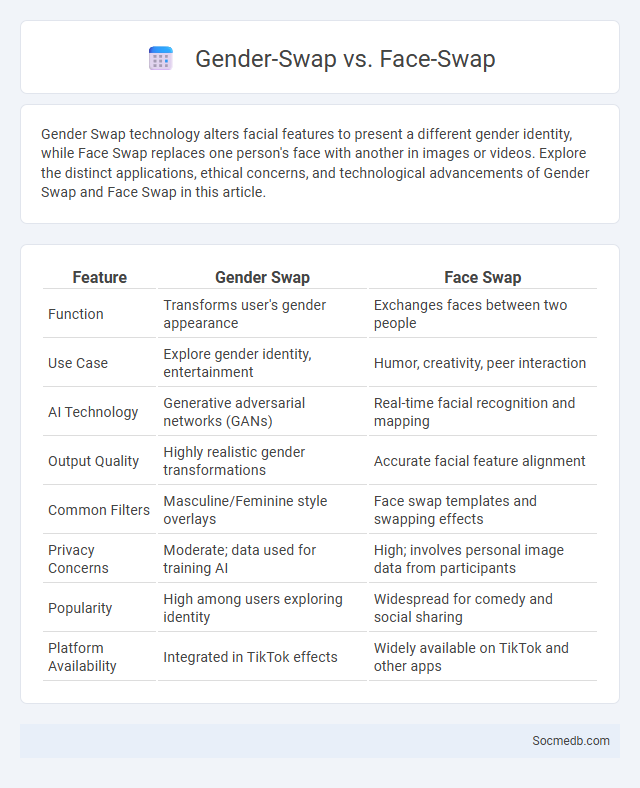
Photo illustration: Gender Swap vs Face Swap
Gender Swap technology alters facial features to present a different gender identity, while Face Swap replaces one person's face with another in images or videos. Explore the distinct applications, ethical concerns, and technological advancements of Gender Swap and Face Swap in this article.
Table of Comparison
| Feature | Gender Swap | Face Swap |
|---|---|---|
| Function | Transforms user's gender appearance | Exchanges faces between two people |
| Use Case | Explore gender identity, entertainment | Humor, creativity, peer interaction |
| AI Technology | Generative adversarial networks (GANs) | Real-time facial recognition and mapping |
| Output Quality | Highly realistic gender transformations | Accurate facial feature alignment |
| Common Filters | Masculine/Feminine style overlays | Face swap templates and swapping effects |
| Privacy Concerns | Moderate; data used for training AI | High; involves personal image data from participants |
| Popularity | High among users exploring identity | Widespread for comedy and social sharing |
| Platform Availability | Integrated in TikTok effects | Widely available on TikTok and other apps |
Introduction to Digital Alteration Technologies
Digital alteration technologies have revolutionized social media by enabling users to enhance, modify, and transform images and videos with unprecedented precision. Tools like AI-powered filters, deepfakes, and augmented reality effects allow creators to craft visually compelling content that captures attention and drives engagement. Harnessing these technologies can elevate your social media presence, making your content more dynamic and impactful.
What is Gender Swap?
Gender swap refers to the digital alteration or portrayal of a person's gender in images, videos, or social media profiles using software or apps. Popular tools like FaceApp and Snapchat utilize AI-driven filters to transform facial features, enabling users to visualize themselves or others as a different gender. This trend encourages creativity and self-expression on platforms such as Instagram, TikTok, and Twitter, often sparking discussions about identity and representation.
What is Face Swap?
Face Swap is a digital technology that uses artificial intelligence and machine learning algorithms to swap faces between two or more individuals within photos or videos. Widely popular on social media platforms, it enables users to create humorous, creative, or surreal content by seamlessly replacing one person's face with another's. This technology leverages deepfake techniques to accurately map facial features and expressions for realistic visual effects.
What are Filters in Photo and Video Apps?
Filters in photo and video apps are digital effects applied to images or footage to enhance or alter their appearance by adjusting colors, brightness, contrast, or adding artistic elements. These presets transform your photos and videos instantly, creating specific moods or styles without the need for advanced editing skills. Using filters allows you to maintain a consistent aesthetic across your social media content, increasing engagement and visual appeal.
Key Differences: Gender Swap vs Face Swap vs Filter
Gender swap, face swap, and filter technologies each manipulate facial images but serve distinct purposes. Gender swap algorithms transform facial features to simulate a different gender by adjusting structural and texture elements, while face swap replaces one person's face with another's using deep learning for seamless integration. Filters modify aspects like color, lighting, or add virtual accessories without changing identity, enhancing user expression and creativity across social media platforms.
Popular Apps for Gender Swap, Face Swap, and Filters
Popular social media apps like Snapchat, TikTok, and Instagram lead in providing advanced gender swap, face swap, and filter features using AI and augmented reality technologies. Snapchat's Cameos and gender swap filters have gained widespread popularity, while TikTok offers face swap effects and diverse AR filters that engage millions daily. Instagram's extensive filter library includes dynamic gender transformation tools and face swap options, enhancing creative expression and entertainment on its platform.
How Each Technology Works: A Technical Overview
Social media platforms operate through a combination of algorithms, data storage, and real-time communication protocols that facilitate user interactions and content delivery. Machine learning algorithms analyze your behavior to personalize feeds, while cloud-based servers ensure scalable storage and fast access to multimedia content. APIs (Application Programming Interfaces) enable seamless integration between different services, allowing your posts to be shared and interacted with across various platforms efficiently.
Social and Cultural Impact
Social media reshapes global communication by influencing cultural norms and social behaviors through instant information sharing and diverse perspectives. Platforms like Facebook, Twitter, and Instagram foster virtual communities, enabling collective identity formation and social activism while challenging traditional cultural boundaries. The pervasive use of social media contributes to both cultural homogenization and the preservation of unique local traditions by amplifying marginalized voices and global trends simultaneously.
Privacy and Ethical Concerns
Social media platforms collect vast amounts of personal data, raising critical privacy concerns about how Your information is stored, shared, and potentially exploited. Ethical issues also emerge from misinformation, targeted advertising, and the manipulation of user behavior, which can impact societal trust and democratic processes. Understanding these risks helps You navigate social media more responsibly and protect Your digital rights.
Future Trends in Digital Photo and Video Editing
Future trends in digital photo and video editing emphasize AI-powered tools that enhance creativity and streamline workflows, enabling more personalized and dynamic content. Advanced features like real-time collaboration, automated enhancements, and immersive AR/VR integration will redefine visual storytelling on social media platforms. By adopting these innovations, your digital content will stay ahead of the curve, captivating audiences and boosting engagement.
 socmedb.com
socmedb.com